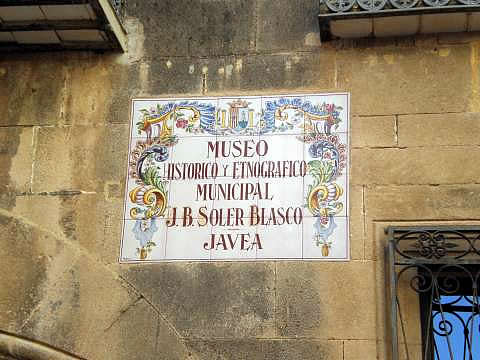|
On November 21st, eleven members of AMUX hiked in the Parque Forestal de la Granadella guided by Ximo Bolufer, Director of the Soler Blasco Museum of Xàbia.
We walked in two groups, leaving the Cala de la Granadella up the dry water course of the Barranc de Martorell. Ximo explained that three major water courses and several other smaller ones converged on the Granadella cove. After about 600m, we turned left to go up a footpath known as the “Gurugú”, since it passes close the top of the Gurugú peak. The name “Gurugú” has an origin in the Berber language and is found in several places in the region. The most famous is Monte Gurugú in Morocco, which was the site of an important battle between local insurgents and Spanish troops during the Rif war in July 1909; Monte Gurugú in Alcalá de Henares, Madrid is said to be where the Spanish cavalry who took part in the war were trained; However, Monte Gurugú in La Granadella does not have such a colourful history, and is just a modest hill some 151m above sea level. We looked back to see the site of the “Les Teuleries de Baix” next to a private house. Here, they used to manufacture roof tiles and bricks for local use. Deposits of suitable clay were found in a nearby stream-bed and there was abundant wood in the area – a vital resource to keep the firing kilns burning. There is also evidence of some ochre mining (yellow and red iron-bearing rock) which was used as a pigment. Looking around, we could see numerous abandoned agricultural terraces. Ximo explained that the soil in La Granadella was of poor quality, and therefore the area had never been densely settled nor farmed intensively. However, subsistence farming took place on these terraces until the 1960’s with crops such as carob, vines, legumes and cereals. Interestingly the farmers were from Benitatxell, not Xàbia. Most of the land now belonged to the Xàbia Town Hall. Although some plots are privately owned, no development is allowed, since the 750 hectare area is fully protected as a LIC (Lugar de Importancia Comunitario) known as the Penyassegats de la Marina. We saw stands of esparto grass (Stima tenacissima) which was used to make rope, baskets and sandals (espadrilles) and a small agricultural hut (casup) with its attendant well. Looking down into the valley of the Barranc de Martorell we saw the ruins of an old farmhouse beneath the cliffs where they once made honey. Ximo pointed out other interesting features such as “check dams” – small dams of stones across water courses, designed to slow torrential flow during the rains as well as a hill overlooking the sea where remains of a look-out from Islamic times have been found. There was also a small, isolated farmhouse in which a leper from Benitatxell had lived. Each day, someone would come to bring food to this unfortunate quarantined man (We felt a particular sympathy with him during these moderns days of Covid!). It is likely this leper would have gone to the leprosarium in Fontilles following its opening in 1909. Finally, before returning to our cars, we enjoyed a panoramic view of the Cala de la Granadella, noting the Torre de Ambolo, the Illa del Decubridor and the Cova del Llop Marí.
0 Comments
|
ACTIVITIES
Categories |
- Home
- Blogs
-
Projectes
- Premio de Investigación - Formularios de Inscripción
-
Traducciones Translations
>
-
DISPLAY PANELS - GROUND FLOOR
>
- THE STONE AGES - PALAEOLITHIC, EPIPALAEOLITHIC AND NEOLITHIC
- CAVE PAINTINGS (ARTE RUPESTRE)
- CHALCOLITHIC (Copper) & BRONZE AGES
- THE IBERIAN CULTURE (THE IRON AGE)
- THE IBERIAN TREASURE OF XÀBIA
- THE ROMAN SETTLEMENTS OF XÀBIA
- THE ROMAN SITE AT PUNTA DE L'ARENAL
- THE MUNTANYAR NECROPOLIS
- ARCHITECTURAL DECORATIONS OF THE PUNTA DE L'ARENAL
- THE ATZÚBIA SITE
- THE MINYANA SMITHY
- Translations archive
- Quaderns: Versión castellana >
- Quaderns: English versions >
-
DISPLAY PANELS - GROUND FLOOR
>
- Catálogo de castillos regionales >
- Exposició - Castells Andalusins >
- Exposición - Castillos Andalusíes >
- Exhibition - Islamic castles >
- Sylvia A. Schofield - Libros donados
- Mejorar la entrada/improve the entrance >
-
Historia y enlaces
-
Historía de Xàbia
>
- Els papers de l'arxiu, Xàbia / los papeles del archivo
- La Cova del Barranc del Migdia
- El Vell Cementeri de Xàbia
- El Torpedinament del Vapor Germanine
- El Saladar i les Salines
- La Telegrafía y la Casa de Cable
- Pescadores de Xàbia
- La Caseta de Biot
- Castell de la Granadella
- La Guerra Civil / the Spanish civil war >
- History of Xàbia (English articles) >
- Charlas y excursiones / talks and excursions >
- Investigacions del museu - Museum investigations
- Enllaços
- Enlaces
- Links
-
Historía de Xàbia
>
- Social media
- Visitas virtuales
- Tenda Tienda Shop


 RSS Feed
RSS Feed
